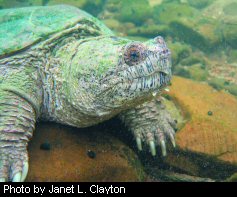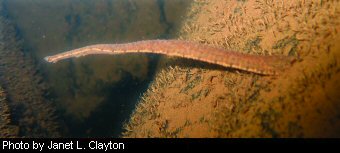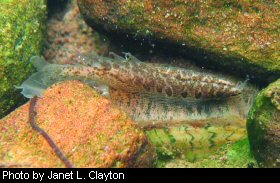

What I Did Last SummerBy Janet Clayton
During a training dive at the Blue Hole on the Tygart River , my dive buddy and fellow biologist got “leeched.” While I was trying to take a picture he was frantically trying to dislodge the leech. No matter how hard I tried to get him to hold still for a picture, he would have nothing to do with it. Of course, if I had been in his place I would have been doing the same thing. Anyhow, once the leech was dislodged from his skin, we proceeded to observe it. This turned out to be a quite a learning situation. Most of us have only observed leeches while attached to us, someone else or maybe even another animal. What was interesting was how the leech sank to the stream bottom and laid flat on a rock. If we moved a hand over the leech it would immediately raise one end off the rock and begin searching for the “host” that it sensed must be overhead. When we would move back away, the leech would settle back to the rock. We did this several times and each time the leech would reach up for its potential host. Light penetration was limited, so more than likely the response was triggered by the leech sensing changes in the water current as the object moved overhead rather than by a shading effect. During the same dive we observed numerous caddisfly nets. These trumpet-shaped nets are built of a silk-like material by larval members of the family With all of the high water last summer, I spent a lot of my time on the Greenbrier River . Due to the limited amount of land disturbance within this watershed, the water remained clear enough to look for mussels even if the water was up slightly. Our main objective for being in the Greenbrier River was to survey the mussel populations. We are currently trying to determine the status of the green floater (Lasmigona subviridis) and determine its preferred habitat. It is a small secretive mussel that prefers areas just out of the main current and therefore is typically covered by a fine layer of silt. As a result, the only thing generally visible are the animal's siphons. Other mussels, such as the wavyrayed lampmussel (Lampsilis fasciola ) which also occurs in the Greenbrier River , display modified mantle flaps that resemble a small darter in hopes of attracting a fish host. In order for mussels to reproduce, their larvae must attach to the gills or fins of a fish for a period of time. To increase the odds of infecting fish, the wavyrayed lampmussel displays its bait to lure in a fish. When the fish takes a bite, instead of getting a meal it gets a mouth full of mussel larvae called glochidia. Mussels such as the plain pocketbook (Lampsilis cardium) which we observed on the Elk River remain buried completely in the substrate most of their lives with only their siphons exposed. This species also has modified mantle flaps which are only displayed during reproductive periods. In the lower siphon, the fleshy gills, which swell with glochidia when pregnant, can be seen. This particular mussel was about the size of a softball. How would you like to be snorkeling along and all of a sudden run into a snapping turtle face to face? We ran into several of these prehistoric-looking creatures While most people are familiar with adult dragonflies or snake doctors, the nymphs are not commonly seen by the average creekside observer. Many dragonflies spend up to of three years as nymphs living in streams, lakes and ponds preying upon other critters. We observed dragonfly nymphs crawling around the rocks in the Greenbrier River searching for a meal. Not only do dragonfly nymphs have to avoid predators like snapping turtles or fish on the prowl, they also have to avoid crayfish. Though searching for mussels gets me in the stream, I never tire of observing all the other large and small critters that also inhabit West Virginia's waters. Janet Clayton is a wildlife biologist stationed in Elkins. |
 I grew up playing in the creeks and woods of West Virginia . Now as a stream biologist for the DNR Wildlife Resources Section, I get to do it for a living. Last summer I encountered many different critters in their natural environment as I conducted mussel surveys throughout the state.
I grew up playing in the creeks and woods of West Virginia . Now as a stream biologist for the DNR Wildlife Resources Section, I get to do it for a living. Last summer I encountered many different critters in their natural environment as I conducted mussel surveys throughout the state.  Polycentropodidae. The nets are used for filtering food in areas of gentle currents where the larva can be found resting in the narrowed base of the net. Some nets are up to four inches long. Similar caddisfly nets were also seen on aquatic plants on the Greenbrier River .
Polycentropodidae. The nets are used for filtering food in areas of gentle currents where the larva can be found resting in the narrowed base of the net. Some nets are up to four inches long. Similar caddisfly nets were also seen on aquatic plants on the Greenbrier River .  throughout the summer as they roamed the stream looking for a juicy meal. Snapping turtles are omnivorous which means they eat whatever they can find including aquatic vegetation, dragonfly nymphs, crayfish, fish, ducklings or even small mammals.
throughout the summer as they roamed the stream looking for a juicy meal. Snapping turtles are omnivorous which means they eat whatever they can find including aquatic vegetation, dragonfly nymphs, crayfish, fish, ducklings or even small mammals.